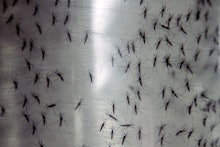Dengue Fever 2015: Here's Everything You Need to Know Around Latest Reported Cases

Two people in Hawaii were said to have dengue fever on Friday, state officials confirmed, while four other potential cases are being investigated by the U.S. Centers for Disease Control and Prevention. The cases include both residents and tourists on the Big Island of Hawaii.
Dengue fever, a virus transmitted by mosquitos, is "a leading cause of illness and death in the tropics and subtropics," according to the CDC. "Although dengue is not endemic to Hawaii, we do have the mosquito species capable of transmitting the disease," state epidemiologist Dr. Sarah Park said, according to a press release. "It's likely an infected traveler infected the local mosquito population, which led to this cluster, so we want the public to be aware of this mosquito-borne disease and the steps they can take to prevent infection."
Here's what else you should know about dengue fever.
How to steer clear: The most assured way to avoid dengue fever is by avoiding mosquito bites. While that's not entirely possible, it's most recommended in areas where the disease is most prevalent. Mosquitos most frequently lay their eggs in water containers, such as flower vases and pet bowls, so the CDC recommends cleaning these at least once a week. It also recommends wearing mosquito repellant while both inside and outside; long sleeves and pants provide additional protection.
Symptoms: Symptoms usually begin within a week of being bitten by an infected mosquito and signs of the virus include high fever, rash, pain behind the eyes, joint or muscle pain and low white blood cell count, according to the CDC. A list of specific symptoms that warrant an immediate trip the the emergency room are available here.
Dengue in isolated areas of the U.S.: Though it's primarily a tropic and subtropic virus, dengue fever has become more prevalent in recent years, according to a 2013 article from Scientific American. Populations of Aedes aegypti, dengue-infected mosquitos, have existed in Tucson, Arizona, and Key West, Florida, for over 20 years, Scientific American reports, however, reported cases in Tucson remain uncertain. Scientists are researching answers to help prevent future viruses. According to the World Health Organization, more than 2.5 billion people, comprising 40% of the world's population, are at risk of contracting the potentially fatal virus.
After roughly 20 cases of dengue fever were reported in Key West in 2010, researchers conducted a study that found a new strain of the virus isolated in that region.
Delhi, India, is currently dealing with the worst dengue fever outbreak there in years — one that's already infected 25,000 people in India in 2015. While most recover after a couple weeks of symptoms, BBC reports, some develop life-threatening symptoms. Doctors are forced to turn 9 out of 10 people away due to the influx of cases.